Experiencing the Way the World Eats
by Lisa Thomas, Project Specialist, Van Horne Elementary School
Like many schools across the United States, our school holds a canned food drive during the winter holiday season. We have been challenging ourselves to support students in taking meaningful action and so began to question this tradition. It became clear that our students were going through the motions of bringing food from their parent’s kitchen cabinets to school. The action that they were engaged in was conceived by someone else and the food that they donated was purchased by someone else. At one point, we were forced to entice students to participate by offering free popcorn to those who brought in cans of food. While we recognize that community food banks rely on these drives, we wanted our students to choose to get involved because they recognized the need within the Tucson community, understood the root causes of hunger, felt compassion and empathy toward those struggling with hunger, and believed that they had the power to address this issue and make the world a better place.
Cowhey (2006) points out that while school food drives are well meaning, they send unintended messages that reinforce stereotypes about the poor, oversimplify the problem and solution, fail to teach an understanding of poverty or local efforts to improve conditions, and further stigmatize low-income children in the school. She states that when children collect canned foods for “poor people,” those efforts make the poor seem like a “predestined, anonymous group” and poverty seem like a “permanent, almost genetic condition” (p. 26). This type of “give the helpless a handout” approach does not help children understand the complex reasons why people are hungry or challenge prevailing stereotypes of poor people as lazy and unintelligent. The solution is oversimplified as simply giving someone a bag of food and the agency and resourcefulness of those who live in poverty and struggle daily to meet their basic needs are not acknowledged.
We knew that our students have good hearts and want to help others, however, they did not understand hunger in a way that would allow them to connect and care. We decided to initiate a school wide inquiry into hunger. We knew that to take more effective and meaningful action, students needed to see hunger as a significant problem in our world and develop a deep understanding of the root causes of hunger. Our inquiry included many invitations for students to think broadly and delve deeply into the complexities of hunger in our world. In developing these experiences, we particularly drew from Kids Can Make a Difference, and their sourcebook, Finding Solutions to Hunger (Kempf, 2005), that contains a range of activities and resources focused on understanding the root causes of hunger (http://www.kidscanmakeadifference.org).
One of the most powerful experiences was our Global Feast. This simulation, developed by Oxfam (http://es.oxfamamerica.org/en), helps students recognize that there is enough food in the world to feed everyone. The common misconception that people go hungry because of inadequate global food supplies is challenged as students experience the unequal distribution of food. This simulation involves the students acting in role as a member of a specific population in the world. This type of drama places students in a fictional role and context to explore and reflect on an issue to generate thoughts, feelings, and language that go beyond typical classroom interactions (O’Neill, 1989).
We intentionally planned the banquet early in our study to provide students with a reference point for thinking about hunger in our community and world. To include everyone in the school, we planned two separate banquets. At each banquet, approximately 100 first through fifth graders filed into the library, anticipating the global feast we had been talking about all week. All the children knew was that an announcement was sent home, saying that they would be eating the way the world eats and that any contributions to support the feast would be greatly appreciated. Some students were concerned that they might be forced to try foods that they didn’t like while others looked forward to a special meal in the middle of the morning.
As the children entered the library, they were randomly given tickets that sorted them into groups. About 12 children in each session received blue tickets, 60 children received yellow tickets, and 28 received red tickets. These numbers roughly represented percentages that exist in the real world related to food and hunger. The children with blue tickets sat at a large banquet tables with fancy plates, napkins, apple juice and flowers. Those with yellow tickets sat at round tables with piles of paper plates, forks and a gallon of drinking water. Children who received red tickets sat on the floor around a tarp with a jug of brownish water and no plates or eating utensils. Each table was labeled with the names of countries where people who fell into that group lived. It was particulary important for us to reinforce with our students that people from all three groups live within the United States, challenging the misconception that people are only starving in other parts of the world.
We welcomed the students to the global feast and reminded them that they would be eating the way that the world eats. We told them that we had very good news — there is enough food in the world for everyone to eat in a way that will allow them to be healthy. We asked them to keep that in mind during our feast.
Because we work with elementary-aged children we knew that it would be a challenge to instill a sense of the magnitute of the world’s hunger problem. We needed to find appropriate ways to ensure that they were able to connect what they learned during the feast experience at school to their world. We would be talking about numbers in the billions with children who were as young as five. We knew that many would have a difficult time conceptualizing a billion — we as adults have a difficult time getting our heads around numbers of that size. We decided that knowing exactly the size of a billion wasn’t necessary as long as children knew it was a lot. To make the idea a little more tangible, we used a page from How Much is a Million, by David M. Schwartz (1998).
“How big is a billion?” I read aloud, “If a billion kids make a human tower, they would stand up past the moon” (Schwartz, 1985). It was clear from their “whoa” responses that the kids were able to connect to this description and saw that a billion was a very large number.
We called the children’s attention to the large numbers on the red, yellow, and blue signs that had been posted near each group. We asked one person from each group to read their number and told them that this is how many people in the world fell into their group. About 12% of the world’s population or 1,000,000,000 people fall into the blue group. About 60% of the world’s population, or 4,000,000,000 are in the yellow group, and the rest of the world’s population, over 25% or 1,800,000,000 are in the red group.
Then it was time to bring in the food. We began with the food for the blue group. In walked two teachers, each carrying six extra large pizzas. They purposely walked past the red and yellow groups so that everyone would be aware of what the blue group was going to eat. Then they placed all 12 pizzas on the banquet table where only 12 children were seated. The room was buzzing with excited children. They all love pizza — and they couldn’t wait to get their share.
Next, we brought in the food for the yellow group. The teachers entered carrying bowls of rice and red beans. After walking past the red and blue groups, one bowl was placed on each of the tables in the yellow group section of the room. The tone in the room shifted from excitement to confusion.
Finally it was time to bring in the food for the red group. Our school couselor brought in one bowl of plain white rice. She walked around the room to show everyone the bowl and then sat it in the center of the tarp where a group of 28 kids were ready to eat. Before we began eating, we asked the kids to do a quick write about what they were thinking.
The quick writes showed that at this point in the experience, most of the students were concerned about the inequity of the immediate situation. Sean, a fourth grader in the yellow group, wrote, “I don’t know if it’s fair because they each get their own pizza and red has to share one bowl. I wish we had pizza. I’m mad.” Stanley, from the red group wrote, “The blue group gets the biggest share of pizza for everyone. The red group barely has any. I think the blue group should share.”
Fourth grader Zachary, who was in the yellow group, immediately applied the simulation to the real world. He wrote, “I have one thing to say about the teacher’s earlier statement, ‘There is enough food for everyone in the world to share.’ Dang rich people! They eat at fancy restaurants every day. Others who don’t have homes have bread and rice.” Zachary didn’t seem to realize that he and his family are members of the world’s blue group — they are those “dang rich people.”
Many of the younger children focused on the way they were feeling. Kindergartener Isaac observed, “People are kind of sad and kind of mad.” Sarah said, “I was really sad to get rice and not water or pizza.”
Before the students ate, we took some time to talk about each group. We told the children that the blue group represented the 1 billion people in the world who have more than enough to eat at all times. These people won’t die of hunger and don’t have to worry about where their next meal will come from. On the other hand, the people in this group tend to eat foods that are very high in fat and sugars and will cause many of them to die of heart disease, obesity, and cancer.
We told the children that the yellow group represented the 4 billion people in the world who get just enough food to eat. They usually get the calories and nutrients that they need to be healthy but not necessarily the foods that they want. Sometimes things happen in these people’s lives and they have to go without food for short periods of time.
We explained that the red group represented the 1.8 billion people in the world who are hungry all of the time. Most of these people live in the southern hemisphere but there are people from the red group living in countries all over the world, including the U.S. They never get enough food to be healthy. They often don’t have access to clean water. Many die everyday from starvation, chronic hunger, and deseases caused by bad drinking water.
To demonstrate the economic insecurity that many people in our world face, we shared a few examples of how changes in circumstance can cause someone from one group to move to another. We wanted to challenge any assumptions that membership in a group is guaranteed or that someone who is hungry today has no hope of ever finding food security. We asked the child with the name John Drew written on his ticket to stand. John was in the blue group. We explained that John works in an electronics store and has lost his job. He has no family to rely on and no savings to fall back on. Without a job, John has no money for food and so he was asked to move from the blue group to the red group. John was very disappointed. The reaction from the rest of the room was mixed; some students felt badly for him, while others were glad that he too would not be getting pizza.
The student with the name Barbara Baker on her ticket was asked to stand. Barb, the children were told, owns a coffee shop. Because the price of coffee has fallen around the world, she is able buy beans for less but still sells coffee at the same price. Even though Barb is already in the blue group, she is now making more money than ever and so would be able to have two helpings of dinner. Barb was pleased with this development, but the students in the rest of the room didn’t like this at all.
The drop in the price of coffee wasn’t good for everyone. Al Hernandez from the red group was asked to stand. He works on a coffee plantation in El Salvador and has lost his job because the price of coffee has fallen. He is no longer able to provide any food at all for his family. Without help they only get water. Since Al was already in the red group, he couldn’t change groups but he was told that he would only get water.
Finally, it was time to eat. Adults waited on the blue group, pouring their apple juice and passing out pizza. The children in the yellow group pitched in to distribute plates and forks to the people at their small group tables. At some tables the children passed around the rice and beans so that each member could help themselves. At other tables, one person served portions of food, making sure everyone had a share.
The behavior at in the red group was different in the two sessions. During the first banquet, Alyssa served the brown water, making sure that everyone got some. The group passed the bowl around the circle, each child scooping out a small handful of rice in an orderly way. Everyone who wanted rice was able to have a small serving, but they weren’t satisfied. Ricky, a kindergardener, wrote, “I was at the red table. I was really sad because we only got rice and brown water. It was not fair. We only got one bowl of rice to share one drink. We had to use our hands to get a handful then pass it.”
Three of the members of the red group in the second banquet refused to eat the rice. They sat at the edge of the tarp staring at the pizzas in the blue group. One of the fourth-grade boys grabbed the bowl of rice and brought it over to his friend. The two of them began gobbling rice with their backs to the group, not allowing any rice for others in their group. Out of frustration, Elizabeth, a third-grade girl from the group went over to the boys and took away the bowl, passing it carefully around the circle, but the rice ran out before everyone was given a portion. The other children in this group were outraged and rumors of the boys’ selfish behavior spread rapidly throughout the school.
After letting the children eat for 10-15 minutes, we asked them to pause and share what they were thinking. Abby, from the red group said, “This is really sad. There isn’t any other food that some kids get to eat. They get flavored food and we get unflavored food and dirty water. We would rather have pizza and not have to use our hands.” Manny from the blue group shared, “Logan said we should share. We have enough food to share.”
In both sessons some of children from the blue group decided that they had enough to share with the other two groups. After convincing the others in their group, they worked together to pass out a piece of pizza to everyone in the room. Once the children had finished eating their pizza, we asked then to do one more quick-write about what they were thinking and what they had learned from the experience. These responses provided us with valuable information about their existing understandings and helped us decide where we needed to go next in our work with children on hunger and taking action.
People that don’t have enough food will die of hunger. The numbers of people who don’t have enough food are huge! There are almost 2 billion people who starve each day. It’s sad to know that we can help more than we have over the years. — Zachary, 4th grade
Some people in the United States are rich like the blue group, but some people are still in the red group. — Stanley, 4th grade
I have helped the hungry. I feel good and feel it’s the perfect feeling. It’s a win-win. But I don’t get more apple juice. I guess its okay. I’m still happy. — Logan, 5th grade
In study group that afternoon teachers discussed what they noticed about their students’ thinking. Teachers felt the feast was beneficial in helping students begin to recognize the problem of hunger, and in helping teachers identify the stereotypes, confusions, misconceptions, and limitations in students’ understandings about hunger and taking action that would need to be challenged during our study.
In reflecting on their students’ written and oral comments during the feast and during their classroom discussions following the feast, teachers noticed that the students understood or were beginning to understand a number of things. Many older children recognized the extreme disparity in the distribution of food and were beginning to see the magnitude of the problem. Their discussions focused on waste and on having enough to share with others. Some students were impressed by the number of people who go hungry every day. In one classroom students wondered how it was possible that someone could have a job and still not have enough money to prevent hunger.
There was evidence of compassion and empathy for the others in many of the students’ responses. Elizabeth and Alyssa made sure that everyone was served within their groups. Morgan, a first grader, wrote, “I feel sad for people who have to suffer for days.” Carah, another first grader, wrote, “I would be heartbroken if I was in the red group.”
In his quick write, Logan, a fifth grader, shared an internal struggle, “I’m thinking that it’s not fair that only we got pizza, but I get it so I don’t care. I do feel sorry that the other people only get rice or rice and beans. The more people, the less food. I get my own pizza. Not everyone can get good food, but I’m lucky and I get good food.” It was interesting that his struggle with this moral dilemma mirrored the tensions that privileged people around the world face. Ultimately, Logan was the person in his group to encourage others to share.
In their writings and classroom discussions following the feast, a number of the fifth graders seemed primarily concerned with liking or not liking the food and didn’t address the broader issue of the inequity of distribution. While some students recognized that hunger exists in our community as well as in other places in the world they seemed to believe that only the homeless go hungry. We knew that we would need to challenge these students in seeing the issue from other perspectives. Hayden, a kindergartener at the blue table, dictated, “I like the pizza. It feels good sitting at the blue table.” He wasn’t yet concerned that there were others who didn’t feel so good.
There was also concern by the adults that the students from the blue group who shared their pizza with the rest of the students did so with a sense of entitlement. Logan was disappointed that only one person told him thank you as he was sharing the pizza. They saw themselves as benevolent and giving to those in need, rather than from a sense of responisibility and concern with inequity. We would have to find ways to help children recognize that people in the world have little control over the economic situation in which they are born — those with food are not more deserving that those without — and that taking action to make the world a better place is a responsibility, not an opportunity to display their generosity for those with less.
The teachers were also concerned that the quick solution — students in the blue group immediately distributing the pizzas to the other groups — may have resulted in a missed opportunity to empathize and understand. They felt that the simple and rapid solution was misleading and took away the children’s chance to stuggle with the tensions that had been introduced.
That same evening, the school had a parent event and so we saw many of our Van Horne families. The parents told the teachers that the kids came home and described the experience in detail. It was clear that the global feast had an immediate impact on students’ thinking about hunger.
Following the feast we moved into engagements that allowed students to think deeply about the range of causes for hunger. We personalized the issue for students using stories, videos, and guest speakers as well as provided them with a range of nonfiction resources that provided facts and statistics. As our study progressed, students made reference to the feast over and over again. They associated the experiences of characters in the stories they read with the group colors and referred to the big numbers that remained posted in the library during their discussions and refections. When asked to create a sketch to stretch of her understandings about taking action at the conclusion of our study, Elizabeth drew red, yellow, and blue people to express her thoughts about the need for everyone (red, blue, and yellow) to work together to help the hungry, as well as the need for a caring heart and ideas about the causes of hunger.
We believe that the Global Feast was memorable because children engaged in an affective as well as cognitive experience. O’Neill (1989) argues that this type of drama experience encourages children to create and retain knowledge as well as to recall the power of feelings generated during the experience. Drama creates an open space that encourages the movement to critical dialogue around multiple voices and perspectives. By carefully examining these perspectives, students have the opportunity to build understandings of the complex ways in which we live in a diverse society and to consider other possibilities for taking action and living in the world.
References
Cowhey, M. (2006). Black ants and Buddhists: Thinking critically and teaching differently in the primary grades. Portland, ME: Stenhouse.
Kempf, S. (2005). Finding solutions to hunger. New York: World Hunger Year (distributed by Kids Can Make a Difference).
O’Neill, C. (1989). Dialogue and drama: The transformation of events, ideas, and teachers. Language Arts, 66(5), 528-540.
Schwartz, D. (1985). How much is a million. New York: Lothrop, Lee & Shepard.
WOW Stories, Volume I, Issue 3 by Worlds of Words is licensed under a Creative Commons Attribution-NonCommercial-ShareAlike 4.0 International License.
Based on a work at https://wowlit.org/on-line-publications/stories/storiesi3/.

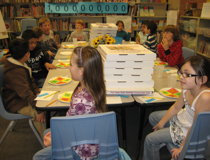
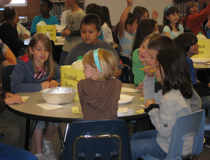
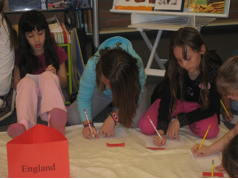
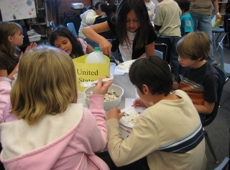
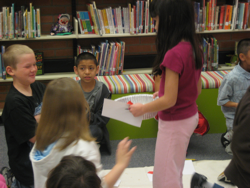
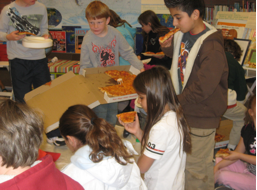
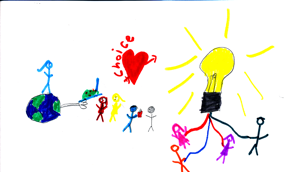
One thought on “WOW Stories: Connections from the Classroom”
Comments are closed.